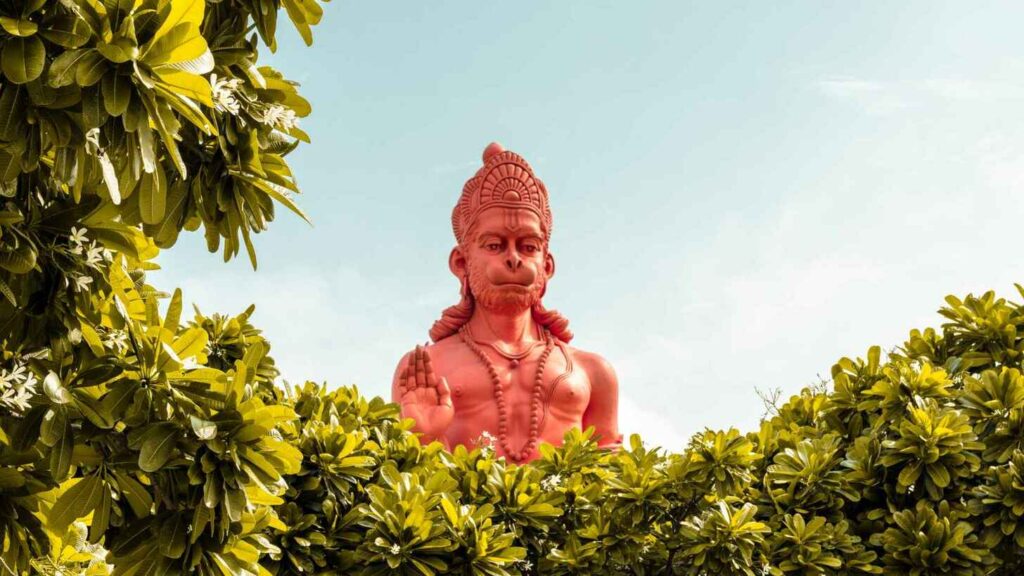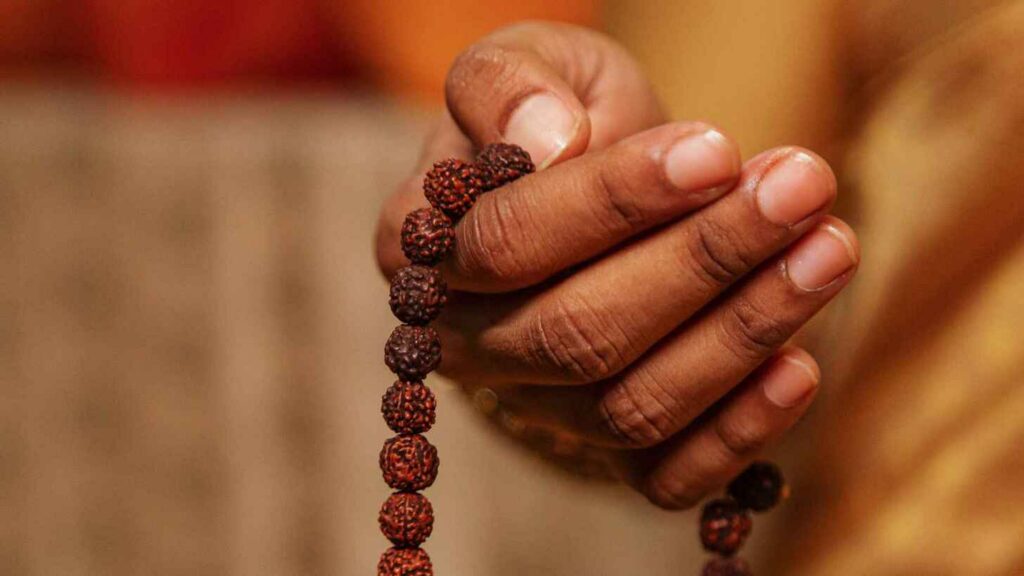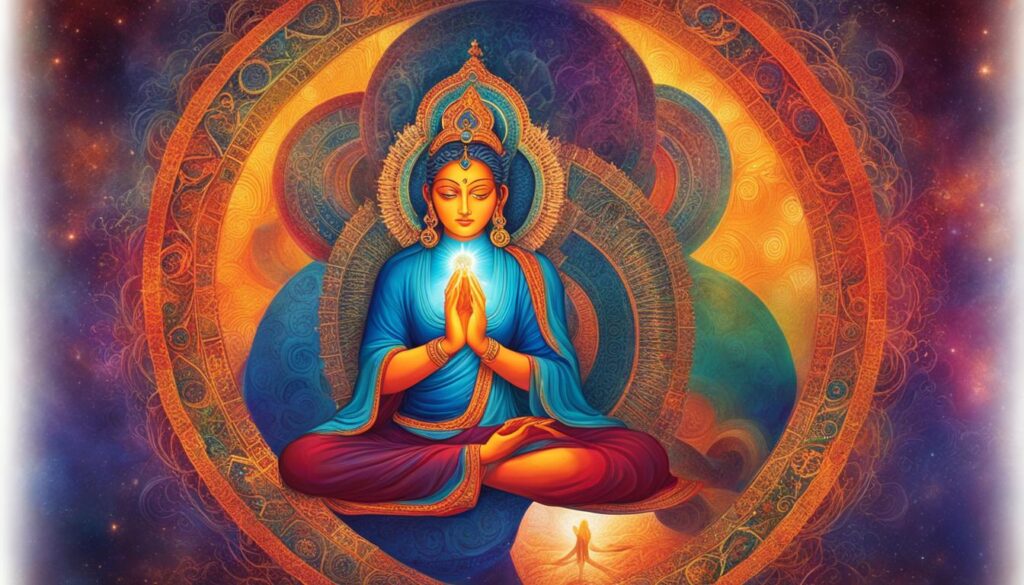Mantra for Brahmacharya will be a turning point in your Brahmacharya Practice. Throughout history, mantras have been used as powerful tools for spiritual growth and discipline. In the practice of brahmacharya, the importance of maintaining purity and self-control is paramount. Chanting specific mantras can be incredibly beneficial in supporting and enhancing the practice of brahmacharya, allowing individuals to access their spiritual strength and navigate the challenges of this path.
In this article, I will introduce you to two highly effective mantras that have been revered for centuries for their therapeutic qualities in strengthening spiritual discipline: “Om Aryamaye Namah” and “Om Namo Bhagavate Mahabale Parakramay.”
These mantras have been sourced from ancient Hindu scriptures and have been passed down through generations of spiritual practitioners. Each mantra carries its own unique symbolism and purpose, contributing to the overall journey of Brahmacharya.
Join me as we explore the meaning and significance of these mantras, their benefits in practising brahmacharya, and the transformational power they hold in our spiritual lives.
Key Takeaways:
- Chanting mantras can support and enhance the practice of brahmacharya.
- The mantras “Om Aryamaye Namah” and “Om Namo Bhagavate Mahabale Parakramay Manobhilashhitam Manah Satambh Kuru Kuru Svaha” are highly effective in maintaining spiritual strength.
- These mantras have been sourced from ancient Hindu scriptures and carry deep spiritual symbolism.
- By incorporating these mantras into your brahmacharya practice, you can experience transformative benefits in your spiritual journey.
- Stay tuned as we delve into the meanings, techniques, and benefits of these mantras in the upcoming sections.
Understanding Brahmacharya and Its Spiritual Significance
In this section, let’s delve into the concept of brahmacharya and its profound spiritual significance. By gaining a deeper understanding of Brahmacharya, we can appreciate its historical context and its role in fostering spiritual growth and self-discipline.
The Concept of Brahmacharya Explained
Brahmacharya, derived from the Sanskrit words “Brahma” (meaning truth, knowledge, and the ultimate reality) and “charya” (meaning path or behaviour), refers to a sacred vow and a way of life focused on channelizing one’s energy towards spiritual pursuits.
It is often associated with celibacy or abstaining from sexual activity, but it encompasses much more than that. Brahmacharya involves cultivating self-restraint, purity, and discipline in thoughts, words, and actions. It encourages individuals to harness their vital life force and direct it towards spiritual awakening, self-realization, and attaining a deep connection with the Divine.
The practice of brahmacharya extends beyond the physical realm and encompasses mental, emotional, and spiritual aspects. It involves aligning one’s desires, intentions, and actions with higher spiritual principles, aiming to transcend worldly attachments and attain self-mastery.
By practising brahmacharya, individuals embark on a transformative journey towards inner harmony, spiritual strength, and ultimate liberation.
Historical Context of Brahmacharya Practices
Brahmacharya has been revered and practised for centuries, dating back to ancient times in India. It finds its roots in the teachings of ancient Hindu scriptures, such as the Vedas, Upanishads, and Yoga Sutras. These texts emphasize the importance of brahmacharya as a foundational practice for spiritual seekers and aspirants.
In the historical context, brahmacharya was primarily associated with the student phase of life, where individuals underwent rigorous education and training under the guidance of spiritual masters or gurus.
The practice of celibacy during this phase aimed to preserve and channel youthful energy towards acquiring knowledge, cultivating virtues, and nurturing spiritual growth. It was believed that through Brahmacharya, students could develop clarity of mind, heightened concentration, and the ability to internalize profound spiritual teachings.
Furthermore, brahmacharya continues to be honoured in various spiritual traditions and monastic orders. Renunciates and monks, who have dedicated their lives to spiritual pursuits, embrace brahmacharya as an essential practice for maintaining purity, conserving energy, and deepening their spiritual connection.
Now that we have explored the concept of brahmacharya and its historical context, let us dive deeper into its spiritual significance and the transformative power it holds in Section 3.
Introduction to Mantras and Their Role in Spiritual Growth
In the journey of spiritual growth, mantras hold immense significance. These sacred sound vibrations have been used for centuries across various spiritual traditions to connect with higher realms, attain inner peace, and cultivate spiritual strength. Mantras play a vital role in supporting and enhancing the practice of brahmacharya, which emphasizes purity and self-discipline.
So, what exactly are mantras? Mantras are powerful phrases or sounds that are repeated or chanted during meditation or daily spiritual practice. Each mantra carries its own unique vibration and meaning, serving as a direct link to specific aspects of divine energy. By chanting mantras, individuals can tap into these energies, reinforcing their connection with the divine and accessing profound states of consciousness.
The power of mantras lies in their ability to create a harmonious blend of sound, intention, and visualization. As one repetitively chants a mantra with focused attention, the mind becomes attuned to the divine vibrations, aligning with the essence of the mantra. This synchronization allows the practitioner to experience subtle shifts in consciousness and tap into the limitless spiritual potential within.
The therapeutic benefits of mantras are multifaceted. They can empower individuals to overcome mental and emotional challenges, release negative patterns, and purify the mind, body, and soul. Mantras have the capacity to evoke deep healing, reduce stress, and enhance overall well-being.
Furthermore, mantras have the power to transform one’s perception of reality. By consistently reciting mantras with devotion, individuals can shift their focus from the external world to the internal realm of divine energy. This shift in perspective fosters a sense of inner peace, clarity, and connection with the divine, facilitating spiritual growth and self-realization.
Embarking on the journey of Brahmacharya requires dedication, discipline, and inner strength. Mantras serve as invaluable tools in supporting and nurturing these qualities, making them an essential part of the spiritual seeker’s toolkit.
Brahmacharya in Different Life Stages According to Vedic Wisdom
Brahmacharya for the Student Phase
In the journey of Brahmacharya, the student phase holds immense significance. It is a time when individuals lay the foundation for a disciplined and virtuous life. According to Vedic wisdom, this is the period when students are encouraged to prioritize their education, spiritual growth, and self-development. Brahmacharya during this stage involves the cultivation of purity, self-control, and the avoidance of distractions that may hinder progress.
Students are advised to practice celibacy and channel their energy towards acquiring knowledge, refining their character, and enhancing their spiritual understanding. By dedicating themselves to their studies, adopting a disciplined routine, and adhering to the principles of brahmacharya, students can lay a strong foundation for a balanced and purposeful life ahead.
Brahmacharya in Household and Renunciate Life
The practice of brahmacharya extends beyond the student phase and continues into the realms of household and renunciate life. In household life, individuals are advised to maintain chastity and fidelity within their committed relationships. This helps cultivate trust, harmony, and a strong foundation for a fulfilling family life.
In the renunciate life, brahmacharya takes on a different dimension. Renunciates, such as monks and nuns, dedicate themselves solely to their spiritual pursuits and detach from worldly desires and attachments. They practice celibacy as a means to conserve and redirect their vital energy towards spiritual growth and self-realization.
In all life stages, brahmacharya is seen as a means to conserve vital energy, enhance spiritual discipline, and cultivate inner strength.
Vedic wisdom emphasizes that brahmacharya is not merely the practice of celibacy but extends to all aspects of life. It involves discipline, self-restraint, and the mindful use of energy in all our thoughts, words, and actions. By adhering to the principles of brahmacharya, individuals can experience enhanced mental clarity, emotional stability, and spiritual progress in their respective life stages.
| Life Stages | Brahmacharya Practices |
|---|---|
| Student Phase |
|
| Household Life |
|
| Renunciate Life |
|
Mantra For Brahmacharya: Om Aryamaye Namah
In the practice of brahmacharya, the mantra “Om Aryamaye Namah” holds immense significance. Chanting this powerful mantra can greatly enhance one’s spiritual strength and discipline. The word “Aryamaye” refers to the Deity Aryama, representing purity, righteousness, and the embodiment of divine qualities.
Rigveda also suggests that Aryama is a supreme deity alongside Mitra and Varuna. According to the Rigveda, Indra, who is traditionally considered the most important deity in the Rigveda, is asked to obtain boons and gifts from Aryaman. Hindu marriage oaths are administered with an invocation to Aryaman being the witness to the event. Aryaman also is the main deity of Pitri Loka or the Planet of Ancestors and the deity of the customs of hospitality.
When we chant “Om Aryamaye Namah,” we connect with the divine energy within us and invoke the blessings of the Deity Aryama. This mantra serves as a reminder to lead a life of purity and to align our thoughts, words, and actions with spiritual principles.
Chanting “Om Aryamaye Namah” helps to purify our minds and cultivate self-discipline. It acts as a guiding force in our journey of brahmacharya, supporting us in maintaining restraint and directing our energy towards spiritual growth.
Through the rhythmic repetition of this mantra 108 times in the morning, 108 times in the evening and 21 times before sleeping, we attune ourselves to the vibrations of the Divine, allowing us to deepen our connection with our higher self and invite spiritual grace into our lives.
Many individuals have experienced a profound transformation and spiritual upliftment through the practice of chanting “Om Aryamaye Namah.” It is a mantra that can awaken dormant spiritual energies within us and bring us closer to the divine essence that resides within.
The Power of Hanuman Chalisa for Brahmacharya

Symbolic Interpretation of Hanuman Chalisa
The Hanuman Chalisa, composed by the great poet Tulsidas, holds immense power for those practising Brahmacharya. Each verse of the Hanuman Chalisa carries a profound symbolic meaning that resonates with the journey of self-discipline and inner strength. The verses narrate the noble qualities of Lord Hanuman, who epitomizes unwavering devotion, courage, and purity.
By chanting the Hanuman Chalisa twice a day in the morning and evening respectively, individuals align themselves with these virtues and invoke the divine energy of Lord Hanuman to support their pursuit of Brahmacharya.
Chanting Hanuman Chalisa for Inner Strength
Chanting the Hanuman Chalisa is a powerful practice that cultivates inner strength and resolve. The rhythmic recitation of the verses creates a vibration that resonates deep within, awakening the dormant spiritual energy. As individuals chant the Hanuman Chalisa with devotion and faith, they invoke the blessings of Lord Hanuman, who empowers them to overcome challenges and temptations on the path of Brahmacharya. The chanting of Hanuman Chalisa serves as a constant reminder of one’s commitment to spiritual growth and helps in maintaining focus and determination.
Mantra Meditation Practices to Support Brahmacharya
In order to deepen your practice of brahmacharya, incorporating mantra meditation can be immensely beneficial. Mantras have the power to calm the mind, focus our thoughts, and connect us to our spiritual strength. In this section, we will explore different mantra meditation practices that specifically support and enhance the practice of brahmacharya.
Setting Up a Meditation Space for Mantra Practice
Creating a dedicated meditation space can greatly enhance your mantra meditation practice. Find a quiet and comfortable area in your home where you can sit undisturbed. Remove any distractions and ensure that the space is clean and peaceful. You may choose to decorate your space with elements that inspire serenity and inner peace, such as candles, incense, or spiritual symbols. Having a designated space solely for your mantra meditation practice will help establish a sense of sacredness and focus.
Techniques for Deepening Mantra Meditation
Here are some techniques to deepen your mantra meditation practice:
- Focus on the sound: As you chant your chosen mantra, focus your attention on the sound and vibration it creates. Let go of any distracting thoughts and immerse yourself fully in the sound of the mantra.
- Meditative breathing: Coordinate your breath with the rhythm of the mantra. Inhale deeply and slowly as you mentally repeat the first part of the mantra, and exhale gradually as you chant the second part. This synchronized breathing will help you enter a meditative state and deepen your connection with the mantra.
- Visualization: As you chant the mantra, visualize the meaning and energy of the words. Imagine the mantra creating a protective and empowering aura around you. This visualization will help you align your intentions with the essence of the mantra.
- Mantra japa: Engage in japa, the repetitive chanting of the mantra. Use a mala (prayer beads) to keep count of your repetitions. Each repetition brings you closer to the essence of the mantra and strengthens your connection with its energy.
By incorporating these techniques into your mantra meditation practice, you can experience a deeper sense of focus, tranquillity, and spiritual strength. Explore these practices and find the ones that resonate with you the most.

Om Namo Bhagavate Mahabale Parakramay Mantra
In the pursuit of brahmacharya, the practice of celibacy and self-discipline, the mantra “Om Namo Bhagavate Mahabale Parakramay Manobhilashhitam Manah Satambh Kuru Kuru Svaha ” holds significant importance. This powerful mantra is known for its ability to support spiritual strength and connect individuals with divine power.
The words “Om Namo Bhagavate Mahabale Parakramay Manobhilashhitam Manah Satambh Kuru Kuru Svaha” hold deep meaning and symbolism. The repetition of this mantra assists in enhancing one’s connection with the divine and cultivating inner strength. Chanting this mantra regularly can contribute to the journey of self-realization and spiritual growth.
This therapeutic mantra for brahmacharya is derived from the teachings of spiritual masters and ancient Hindu scriptures. It has been embraced by practitioners for centuries and is believed to have profound effects on spiritual discipline and self-control.
Chanting the “Om Namo Bhagavate Mahabale Parakramay Manobhilashhitam Manah Satambh Kuru Kuru Svaha” mantra 21 times in the morning while looking at a glass of milk and then drinking it, can help individuals tap into their spiritual strength, providing them with the courage and resolve necessary for maintaining brahmacharya. Through regular practice, this mantra can offer guidance and support along the path of self-restraint and spiritual purity.
To experience the transformative effects of this mantra, individuals are encouraged to incorporate regular chanting into their spiritual routine. By fully immersing themselves in the vibration and resonance of the mantra, they can harness its spiritual power and unlock their true potential on the path of Brahmacharya.
“Chanting the powerful mantra, ‘Om Namo Bhagavate Mahabale Parakramay manobhilashhitam Manah Satambh Kuru Kuru Svaha,’ has strengthened my spiritual discipline and helped me maintain brahmacharya. The mantra has provided me with the spiritual strength and resolve to overcome challenges along the way.” – Devotee
When harnessing the power of this mantra, it is essential to approach it with reverence and focus. Finding a quiet and peaceful environment can enhance the effectiveness of the chanting practice. By creating a dedicated space for mantra meditation, individuals can immerse themselves fully in the vibrations and energy of the “Om Namo Bhagavate Mahabale Parakramay Manobhilashhitam Manah Satambh Kuru Kuru Svaha” mantra.
Through the consistent and heartfelt chanting of this mantra, individuals can experience its therapeutic benefits and witness its profound impact on their spiritual strength and brahmacharya practice. As they connect with the divine energy embodied in the mantra, they strengthen their commitment to self-discipline and spiritual growth.
By embracing the power of the “Om Namo Bhagavate Mahabale Parakramay Manobhilashhitam Manah Satambh Kuru Kuru Svaha” mantra, practitioners of Brahmacharya can tap into their inner reservoir of strength and amplify their spiritual journey. This mantra serves as a guiding light, supporting individuals in cultivating purity, discipline, and self-realization on the path of Brahmacharya.
Science Behind Mantra Chanting and Its Therapeutic Effects
In this section, we will explore the scientific aspects of mantra chanting and its therapeutic effects. Mantras have been used for centuries in various spiritual traditions, but they also have a profound impact on our psychological and physiological well-being. Understanding the science behind mantra chanting can help us harness the full potential of these ancient practices and enhance our overall health and well-being.
Psychological and Physiological Impact of Mantras
The repetition of mantras has been found to have a calming effect on the mind, reducing stress levels, and promoting a sense of peace and tranquility. Chanting mantras can help release endorphins, which are natural mood-enhancing chemicals that contribute to a sense of well-being and happiness.
Research has also shown that mantra chanting can positively influence brain activity. The rhythmic repetition of sounds activates specific areas of the brain associated with focus, attention, and relaxation. This can lead to improved cognitive function, increased mental clarity, and enhanced overall brain health.
Furthermore, mantra chanting has been found to have a direct impact on our physiology. When we chant mantras, our breathing pattern synchronizes with the rhythm of the chant, resulting in deep and controlled breathing. This deep breathing stimulates the parasympathetic nervous system, promoting relaxation, reducing blood pressure, and improving heart health.
Research on Sound Healing and Mantra Chanting
Scientific studies have also explored the therapeutic benefits of mantra chanting and sound healing. Sound vibrations produced during mantra chanting create a resonance in our bodies, affecting our energy centres and promoting balance and harmony. This phenomenon, known as sound healing, has been found to have a profound impact on our physical, emotional, and spiritual well-being.
Research on sound healing and mantra chanting has shown promising results in various areas, including stress reduction, pain management, and improved sleep quality. The vibrations generated by mantras can also enhance immune function, boost energy levels, and support the body’s natural healing processes.
By understanding the science behind mantra chanting and the therapeutic effects it can have on our mind, body, and spirit, we can fully embrace these practices and experience their profound benefits in our daily lives.

Summary of Scientific Findings on Mantra Chanting
| Effect | Scientific Evidence |
|---|---|
| Reduced stress and anxiety | Research has shown that mantra chanting promotes relaxation reduces stress hormone levels, and induces a sense of calmness. |
| Improved cognitive function | Studies have found that chanting mantras enhances attention, focus, and memory, leading to improved cognitive performance. |
| Enhanced emotional well-being | Mantra chanting has been associated with increased positive emotions, improved mood, and reduced symptoms of depression and anxiety. |
| Boosted immune system | The vibrations produced during mantra chanting stimulate the release of immune-boosting substances, strengthening the body’s natural defence mechanisms. |
| Pain management | Some studies suggest that mantra chanting can alleviate pain and discomfort, providing a natural and holistic approach to pain management. |
| Improved sleep quality | Research indicates that mantra chanting can promote deep relaxation, leading to improved sleep quality and reduced sleep disturbances. |
From reducing stress and anxiety to improving cognitive function and boosting the immune system, scientific findings strongly support the therapeutic effects of mantra chanting. Incorporating these ancient practices into our daily lives can have profound benefits for our overall well-being.
Mantra Healing for Brahmacharya: Sourcing Spiritual Energy
In the journey of Brahmacharya, mantra healing plays a significant role in sourcing spiritual energy and transmuting sexual energy for spiritual growth and self-realization. Through the power of mantras, practitioners can tap into their inner reservoirs of strength and channel their sexual energy towards spiritual pursuits. The transformative effects of mantra healing have been experienced by individuals from various walks of life, who have graciously shared their personal testimonies.
Transmuting Sexual Energy Through Mantras
One of the key aspects of mantra healing is the transmutation of sexual energy. By directing this potent energy towards spiritual practices, individuals can harness its power and channel it into higher realms of consciousness. Mantras act as a catalyst, helping to dissolve the lower impulses associated with sexual energy and redirecting it towards inner transformation and spiritual awakening.
Mantras serve as a transformative tool, allowing practitioners to shift their focus from the physical to the spiritual plane. This process of transmutation enables individuals to cultivate self-mastery, discipline, and a deeper connection with their spiritual essence. Through the consistent practice of mantra healing, practitioners can experience a profound shift in their relationship with their sexual energy, elevating it to a sacred and transformative force.
To facilitate the transmutation of sexual energy, specific mantras are often used in the practice of brahmacharya. The vibrations and resonance created by these mantras help raise consciousness and harmonize the energies within the body, allowing for a more seamless integration of sexual energy into the spiritual path.
Personal Testimonies on Mantra Healing
“Chanting mantras for brahmacharya has been a life-changing experience for me. It has allowed me to tap into a deep well of spiritual energy and strengthen my commitment to self-discipline. Through the power of mantra healing, I have experienced a profound transformation in my relationship with my sexuality and a heightened sense of spiritual connection.” – Rahul
“Mantra healing has been instrumental in my journey of brahmacharya. Through consistent mantra practice, I have been able to navigate the challenges of transmuting sexual energy and aligning it with my spiritual aspirations. The tangible benefits I have experienced, both in terms of inner growth and self-realization, have been beyond my expectations.” – Priya
Personal testimonies like these provide profound insights into the transformative power of mantra healing in the practice of brahmacharya. The accounts of individuals who have incorporated mantras into their spiritual journey serve as valuable guidance and inspiration for others seeking a similar path.
Integrating Brahmacharya Mantras into Daily Life
Incorporating mantra practice into daily life is essential for maintaining the spiritual discipline of Brahmacharya. Here are some practical tips to help you integrate Brahmacharya mantras into your daily routine:
Tips for Consistent Mantra Practice
- Set a specific time: Choose a dedicated time each day to chant your chosen Brahmacharya mantra. Creating a regular schedule will ensure consistency and make it easier to establish a habit.
- Create a sacred space: Designate a quiet and peaceful area in your home where you can practice your mantra without distractions. This space will help you cultivate a sense of focus and reverence during your practice.
- Start with short sessions: Begin with shorter mantra chanting sessions, gradually increasing the duration over time. This gradual approach will help you develop endurance and prevent burnout.
- Use reminders: Set reminders on your phone or place visual cues in your environment to remind you of your mantra practice. These reminders can be gentle prompts to maintain consistency throughout the day.
- Seek guidance: Connect with spiritual mentors or practitioners experienced in Brahmacharya mantra practice. They can provide insights, answer questions, and offer support to help you stay on track with your practice.
Overcoming Challenges in Maintaining Brahmacharya
Maintaining brahmacharya can come with its fair share of challenges. Here are some strategies to overcome common obstacles:
- Stay committed: Remind yourself of the significance and purpose of your Brahmacharya practice. Strengthen your resolve and remember the long-term benefits that come with maintaining spiritual discipline.
- Cultivate self-discipline: Develop self-discipline by establishing healthy habits in other areas of your life. This will create a strong foundation for maintaining brahmacharya and make it easier to stay committed to your mantra practice.
- Practice self-reflection: Regularly reflect on your progress and identify any challenges or obstacles that may be hindering your Brahmacharya practice. Self-reflection will help you address these challenges and find appropriate solutions.
- Seek support: Reach out to like-minded individuals or join spiritual communities that share similar values. Surrounding yourself with supportive people can provide inspiration and encouragement during challenging times.
- Adapt to change: Embrace flexibility in your mantra practice, allowing it to evolve as circumstances change. Adjust your practice to fit your lifestyle while remaining true to the essence of brahmacharya.
By integrating brahmacharya mantras into your daily life and implementing these tips for consistent practice, you can overcome challenges and experience the transformative power of mantras in your spiritual journey.

| Tips for Consistent Mantra Practice | Overcoming Challenges in Maintaining Brahmacharya |
|---|---|
| Set a specific time | Stay committed |
| Create a sacred space | Cultivate self-discipline |
| Start with short sessions | Practice self-reflection |
| Use reminders | Seek support |
| Seek guidance | Adapt to change |
Incorporating Beej Mantra for Brahmacharya in Spiritual Routine
When it comes to maintaining and enhancing the practice of brahmacharya, incorporating beej mantra chanting into your spiritual routine can be highly beneficial. Beej mantras are powerful seed syllables or sounds that hold profound spiritual and transformative qualities. By including beej mantra chanting in your daily practice, you can cultivate purity, discipline, and spiritual strength.
The significance of beej mantras lies in their vibrational energy, which resonates with specific aspects of consciousness. These mantras help to awaken and activate the divine qualities within ourselves, leading to a deeper connection with our spiritual nature. Chanting beej mantras can bring clarity, focus, and a sense of inner peace, supporting the journey of Brahmacharya.
To incorporate beej mantra chanting into your spiritual routine, consider the following practices:
- Choose a beej mantra: Select a beej mantra that resonates with your spiritual intentions. Common beej mantras for brahmacharya include “Om Aryamaye Namah” and “Om Durga Devyei Namah.”
- Set aside dedicated time: Create a specific time each day for your mantra practice. It could be in the morning or evening, depending on your preference and schedule. Consistency is key.
- Find a quiet space: Create a peaceful environment for your practice. Find a quiet room or corner where you can sit undisturbed and focus on your mantra chanting.
- Begin with breath awareness: Before chanting the beej mantra, take a few moments to focus on your breath. This helps to calm the mind and prepare you for the practice.
- Chant with devotion: As you start chanting the beej mantra, bring a sense of devotion and surrender to your practice. Allow the energy of the mantra to flow through you, awakening your inner spiritual strength.
- Repeat the mantra: Chant the beej mantra aloud or silently, continuously repeating it for a specific duration. You can use a mala or rosary beads to count your repetitions if desired.
- Connect with the energy: As you chant the beej mantra, visualize and feel the energy associated with it. Immerse yourself in the vibrations and allow them to permeate your entire being.
- End with gratitude: After your mantra practice, take a few moments to express gratitude for the divine energy and blessings you have received. Reflect on the transformative power of the beej mantra in your journey of Brahmacharya.
By incorporating beej mantra chanting into your spiritual routine, you can deepen your connection with your spiritual strength and cultivate a greater sense of purity and discipline in the practice of brahmacharya.
Conclusion
In conclusion, the practice of brahmacharya can be greatly enhanced by incorporating therapeutic mantras into one’s spiritual journey. Throughout this article, we have explored two powerful mantras that have been traditionally used for centuries: “Om Aryamaye Namah” and “Om Namo Bhagavate Mahabale Parakramay Manobhilashhitam Manah Satambh Kuru Kuru Svaha.” These mantras hold deep symbolism and carry the potential to strengthen spiritual strength and discipline.
By chanting these mantras, individuals can cultivate a deeper connection with their spiritual selves and tap into their inner reservoirs of strength. The vibrations of the mantras resonate within, calming the mind, and aiding in maintaining brahmacharya. These mantras serve as powerful tools for focusing the mind, purifying thoughts, and transmuting sexual energy towards spiritual growth.
As we have seen from the teachings of spiritual masters and the wisdom of ancient Hindu scriptures, mantras have the ability to positively impact one’s psychological and physiological well-being. They have been scientifically proven to have therapeutic effects, contributing to overall mental and emotional balance. Incorporating mantra meditation practices in daily life and setting up a dedicated meditation space can deepen one’s connection with the mantras and amplify their transformative effects.
Incorporating beej mantras and exploring the power of the Hanuman Chalisa are additional avenues to support the practice of brahmacharya. The beej mantra “Om Durga Devyei Namah” can be chanted to harness spiritual energy, while the Hanuman Chalisa serves as a powerful hymn for cultivating inner strength and resolve. Through consistent mantra practice and the support of these powerful tools, individuals can overcome challenges in maintaining brahmacharya and experience profound spiritual growth.
In summary, the ancient practice of brahmacharya can be enriched by the practice of therapeutic mantras. Whether it is chanting “Om Aryamaye Namah,” “Om Namo Bhagavate Mahabale Parakramay Manobhilashhitam Manah Satambh Kuru Kuru Svaha,” or exploring the power of the Hanuman Chalisa and beej mantras, these mantras offer a pathway towards spiritual discipline and self-realization. I encourage you to explore and incorporate these mantras into your own spiritual journey as you embrace the transformative power of mantra practice for maintaining brahmacharya.
Best Recommended Brain Rewire Course To Boost Your Brahmacharya Practice
FAQ
What is the significance of mantras for maintaining brahmacharya?
Mantras have been used for centuries to support and enhance the practice of brahmacharya. Chanting mantras can strengthen spiritual discipline, cultivate inner strength, and cultivate purity and self-control.
Can anyone practice Brahmacharya, or is it only for certain individuals?
Brahmacharya can be practised by individuals from all walks of life, regardless of gender or age. It is a path of self-discipline and spiritual growth that anyone can embark on.
How long should I chant the mantras for Brahmacharya?
The duration of mantra chanting for Brahmacharya can vary depending on personal preference and schedule. It is recommended to chant the mantras consistently for a dedicated period of time each day to reap the maximum benefits.
Are there any specific guidelines or rituals to follow while chanting mantras for brahmacharya?
While there are no rigid rules or rituals, it is important to create a conducive environment for mantra chanting. Find a quiet and clean space, sit in a comfortable posture, and focus your attention on the mantra. You can also use mala beads to keep track of the number of repetitions.
Can I chant the mantras silently in my mind, or do I need to vocalize them?
Both silent and vocalized chanting can be effective for maintaining brahmacharya. Choose the method that resonates with you and allows you to feel a deep connection with the mantra.
Can chanting mantras for Brahmacharya help with overcoming sexual desires?
Chanting mantras can help channel and transmute sexual energy towards spiritual growth and self-realization. It can support individuals in maintaining purity and discipline, and cultivate a higher state of awareness.
Are there any precautions or contraindications for practising the mantra for Brahmacharya?
Mantra practice for Brahmacharya is generally safe and beneficial. However, if you have any specific medical or psychological conditions, it is advisable to consult with a qualified teacher or healthcare professional before incorporating mantra chanting into your routine.
Can I combine different mantras for Brahmacharya in my practice?
Yes, you can combine different mantras for Brahmacharya based on your personal preference and spiritual goals. Experiment with different mantras and find the combination that resonates with you and supports your spiritual journey.
Can I chant mantras for Brahmacharya in any language?
Mantras can be chanted in any language, as long as you understand the meaning and resonate with the intention behind the mantra. However, Sanskrit is traditionally used in the practice of brahmacharya and is considered highly potent for spiritual growth.
How long does it take to see the benefits of mantra practice for Brahmacharya?
The benefits of mantra practice for brahmacharya can vary from individual to individual. It may take time to experience the full impact of mantra chanting, but with consistent practice and dedication, you can start noticing positive changes in your spiritual growth and self-discipline.




